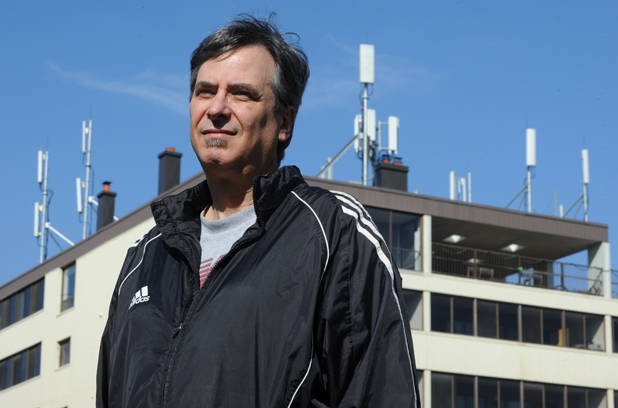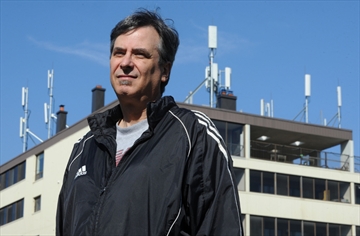October 29, 2012 By Staff – Metroland News Service

Metroland News Service
Howard Kalnitsky stands near a Beechwood Drive apartment building bristling with antennae, Monday. Kalnitsky claims his hypersensitivity to cell phone radiation has caused him heart problems.
WATERLOO — When Howard Kalnitsky started experiencing heart problems 15 years ago at age 34, he wasn’t sure what to think.
After years of medication, he now says he’s affected by electromagnetic hypersensitivity — a nervous system reaction to wireless radiation from cellphones, internet and other technologies.
“My wife said that I had turned into this old, frail man overnight,” Kalnitsky said.
But the question of whether electromagnetic fields actually make people sick is a matter of debate.
Health Canada says there is no scientific evidence proving symptoms of apparent electromagnetic hypersensitivity are actually caused by electromagnetic fields.
“If you have a look at the body of evidence, there is no indication that technology such as Wi-Fi and cellphones represent a health concern,” said Dr. Hsiu-Li Wang, associate medical officer of health with Region of Waterloo Public Health.
“We do know that it is a field of ongoing study and that’s a good thing. We do know that Health Canada continues to monitor the science.”
Magda Havas disagrees. She is associate professor of environmental and resource studies at Trent University in Peterborough and has researched electromagnetic hypersensitivity for two decades.
Symptoms include everything from headaches, trouble concentrating and difficulty with short term memory to heart problems, mood disorders and anxiety.
“This issue is not going to go away,” Havas said. “It’s going to get a lot worse.”
Children, the elderly and those with weak immune systems are more likely to develop symptoms, Havas said.
Kalnitsky says he self-diagnosed after speaking with an expert. He unplugged his wireless internet, mobile and cordless phones for a few days. The difference was drastic.
“The next day after I had disconnected, I felt different, I felt energy,” he said. “I’ve been perfectly healthy with no arhythmia for more than a year.”
Kalnitsky’s doctor, Dr. Kathleen Debrosian, declined comment to The Record to confirm his diagnosis.
The Women’s College Hospital Environmental Health Clinic in Toronto is one of the few places to provide electromagnetic hypersensitivity diagnoses.
Dr. Riina Bray is medical director of the clinic and sees about 50 patients per year she says are affected.
“Maybe one per cent of the population (is affected),” she said. “We really don’t know.”
The legislation covering the level of radiation broadcasting and telecommunications devices can emit here is Safety Code 6. Industry Canada governs the legislation, which is based on Health Canada recommendations. It says 1000 microwatts per centimetre squared can be emitted constantly to be safe.
Havas said countries like Russia have much lower thresholds.
Bray said skeptics and government need to do their homework.
“It’s a real thing,” she said. “It’s not a psychological problem.”
Judi Francioso of Cambridge said her family suffered headaches, heart palpitations and other symptoms after a smart meter was installed at the home in June 2010.
She wants people to take the problem seriously.
“We sufferers sound pretty stupid talking about this when no one else can feel this,” she said.
After being diagnosed at Bray’s clinic, Francioso fought for months to have her smart meter replaced with one connected to a land line. Symptoms have improved little since the meter was replaced earlier this year.
Kalnitsky says he will meet with city officials and talk about where cellphone towers are placed. But he may be out of luck.
The ultimate administration over where towers go is left to the federal government.
“I certainly empathize with the symptoms that (Kalnitsky) is reporting,” said Peter Braid, MP for Kitchener-Waterloo. “These policies are based on science and, according to Health Canada, there is nothing — no evidence of radiofrequency signals causing adverse health effects.”
He said if that were to change, so too would policy.
http://metronews.ca/news/kitchener/420468/waterloo-man-blames-wi-fi-for-sickness/
‘I had turned into this old, frail man overnight’
Waterloo man blames sickness on wireless technology, but health officials say there’s no link

Mathew McCarthy/Record staff
Waterloo Region Record
WATERLOO — When Howard Kalnitsky started experiencing heart problems 15 years ago at age 34, he wasn’t sure what to think.
After years of medication, he now says he’s affected by electromagnetic hypersensitivity — a nervous system reaction to wireless radiation from cellphones, internet and other technologies.
“My wife said that I had turned into this old, frail man overnight,” Kalnitsky said.
But the question of whether electromagnetic fields actually make people sick is a matter of debate.
Health Canada says there is no scientific evidence proving symptoms of apparent electromagnetic hypersensitivity are actually caused by electromagnetic fields.
“If you have a look at the body of evidence, there is no indication that technology such as Wi-Fi and cellphones represent a health concern,” said Dr. Hsiu-Li Wang, associate medical officer of health with Region of Waterloo Public Health.
“We do know that it is a field of ongoing study and that’s a good thing. We do know that Health Canada continues to monitor the science.”
Magda Havas disagrees. She is associate professor of environmental and resource studies at Trent University in Peterborough and has researched electromagnetic hypersensitivity for two decades.
Symptoms include everything from headaches, trouble concentrating and difficulty with short term memory to heart problems, mood disorders and anxiety.
“This issue is not going to go away,” Havas said. “It’s going to get a lot worse.”
Children, the elderly and those with weak immune systems are more likely to develop symptoms, Havas said.
Kalnitsky says he self-diagnosed after speaking with an expert. He unplugged his wireless internet, mobile and cordless phones for a few days. The difference was drastic.
“The next day after I had disconnected, I felt different, I felt energy,” he said. “I’ve been perfectly healthy with no arhythmia for more than a year.”
Kalnitsky’s doctor, Dr. Kathleen Debrosian, declined comment to The Record to confirm his diagnosis.
The Women’s College Hospital Environmental Health Clinic in Toronto is one of the few places to provide electromagnetic hypersensitivity diagnoses.
Dr. Riina Bray is medical director of the clinic and sees about 50 patients per year she says are affected.
“Maybe one per cent of the population (is affected),” she said. “We really don’t know.”
The legislation covering the level of radiation broadcasting and telecommunications devices can emit here is Safety Code 6. Industry Canada governs the legislation, which is based on Health Canada recommendations. It says 1000 microwatts per centimetre squared can be emitted constantly to be safe.
Havas said countries like Russia have much lower thresholds.
Bray said skeptics and government need to do their homework.
“It’s a real thing,” she said. “It’s not a psychological problem.”
Judi Francioso of Cambridge said her family suffered headaches, heart palpitations and other symptoms after a smart meter was installed at the home in June 2010.
She wants people to take the problem seriously.
“We sufferers sound pretty stupid talking about this when no one else can feel this,” she said.
After being diagnosed at Bray’s clinic, Francioso fought for months to have her smart meter replaced with one connected to a land line. Symptoms have improved little since the meter was replaced earlier this year.
Kalnitsky says he will meet with city officials and talk about where cellphone towers are placed. But he may be out of luck.
The ultimate administration over where towers go is left to the federal government.
“I certainly empathize with the symptoms that (Kalnitsky) is reporting,” said Peter Braid, MP for Kitchener-Waterloo. “These policies are based on science and, according to Health Canada, there is nothing — no evidence of radiofrequency signals causing adverse health effects.”
He said if that were to change, so too would policy.
http://www.therecord.com/news-story/2622327–i-had-turned-into-this-old-frail-man-overnight-/

#1 by Howard Kalnitsky on October 31, 2012 - 9:44 pm
The original article blames wireless technologies not wifi..when Metroland picked this up someone re-wrote the by line with wifi..
Here is the correct original link:
http://www.therecord.com/news/local/article/826236—i-had-turned-into-this-old-frail-man-overnight
#2 by admin on January 23, 2015 - 4:32 pm
Thanks Howard for the Update